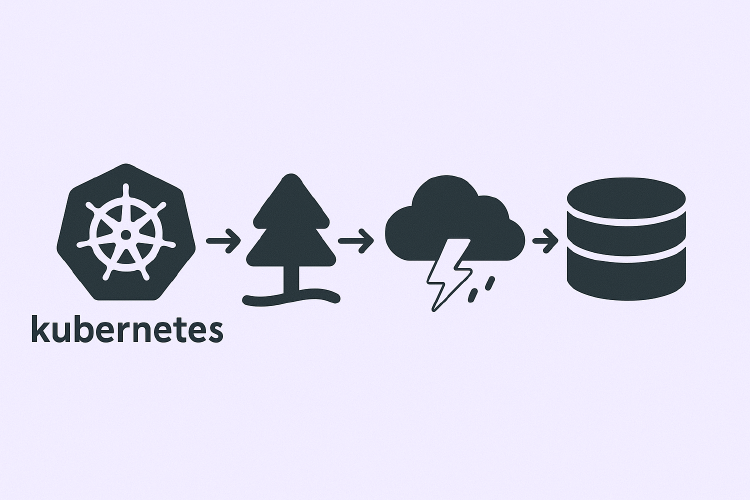Kubernetes Disaster Recovery: Lessons from Natural Disasters
How to design resilient Kubernetes clusters that can survive real disasters - insights from living through earthquakes, tsunamis, and typhoons in Japan.

- Dr. Vivek Shilimkar
- 6 min read

Introduction
Living in Japan for several years as a climate scientist taught me profound lessons about resilience—not just in natural systems, but in how we design and operate technology infrastructure. When you’ve experienced a 6.7 earthquake, felt the ground shake for almost minute, and watched earthquake warnings scroll across every screen, you gain a visceral understanding of what “disaster recovery” really means.
As a Site Reliability Engineer working with Kubernetes, I’ve learned to apply these hard-earned lessons about natural disaster preparedness to distributed systems design. The principles that help societies survive earthquakes and typhoons are remarkably similar to those that keep our clusters running during outages, data center failures, and regional disasters.
The Reality of Disasters: Lessons from Japan
When the Ground Literally Moves
In September 2018, I experienced firsthand the 6.7 magnitude earthquake that struck Hokkaido, centered near Sapporo. What struck me wasn’t just the immediate power outages and infrastructure damage, but how well-prepared systems continued functioning while unprepared ones failed catastrophically.
Key observations:
- Cascading failures: One failure triggered multiple downstream failures
- Communication breakdown: Networks became congested when everyone needed them most
- Resource scarcity: Power, bandwidth, and personnel became critically limited
- Geographic correlation: Entire regions could become simultaneously unavailable
These patterns mirror exactly what happens during large-scale infrastructure outages in cloud environments.
Designing Kubernetes Clusters for Real Disasters
1. Multi-Region Architecture: Geographic Distribution
Just as Japan’s infrastructure spans multiple seismic zones, your Kubernetes workloads should span multiple failure domains.
# Example: Multi-region cluster federation
apiVersion: v1
kind: ConfigMap
metadata:
name: cluster-regions
data:
primary: "us-east-1"
secondary: "us-west-2"
tertiary: "eu-west-1"
---
apiVersion: apps/v1
kind: Deployment
metadata:
name: critical-app
spec:
replicas: 9
template:
spec:
affinity:
podAntiAffinity:
requiredDuringSchedulingIgnoredDuringExecution:
- labelSelector:
matchLabels:
app: critical-app
topologyKey: "topology.kubernetes.io/zone"
Best Practices:
- Deploy across at least 3 availability zones
- Use different cloud providers for true independence
- Consider latency vs. resilience trade-offs
- Implement active-active patterns where possible
2. Data Backup and Replication Strategies
During the 2018 Hokkaido earthquake, I witnessed how quickly critical infrastructure could fail. The half the island lost electrical power within minutes, and I watched as unprepared systems went dark while resilient ones continued operating on backup power and redundant connections. Digital assets need similar protection.
# Velero backup configuration for disaster recovery
apiVersion: velero.io/v1
kind: Schedule
metadata:
name: disaster-recovery-backup
spec:
schedule: "0 2 * * *" # Daily at 2 AM
template:
includedNamespaces:
- production
- critical-apps
storageLocation: multi-region-backup
volumeSnapshotLocations:
- aws-east
- aws-west
ttl: 720h # 30 days retention
Critical backup considerations:
- 3-2-1 Rule: 3 copies, 2 different media types, 1 offsite
- Cross-region replication: Don’t keep all backups in one region
- Regular restore testing: Backups are useless if you can’t restore
- Encryption: Protect data both in transit and at rest
3. Network Resilience and Communication
When disaster strikes, network congestion can cripple response efforts. Design for degraded connectivity.
# Network policies for disaster scenarios
apiVersion: networking.k8s.io/v1
kind: NetworkPolicy
metadata:
name: disaster-mode-policy
spec:
podSelector:
matchLabels:
tier: critical
policyTypes:
- Ingress
- Egress
ingress:
- from:
- namespaceSelector:
matchLabels:
name: emergency-services
egress:
- to:
- namespaceSelector:
matchLabels:
name: essential-services
ports:
- protocol: TCP
port: 443
Network resilience strategies:
- Circuit breakers: Prevent cascade failures
- Rate limiting: Preserve resources during stress
- Multiple connectivity paths: Don’t rely on single ISPs
- Service mesh: Implement intelligent routing and failover
Operational Patterns from Disaster Response
1. Incident Command System (ICS) for Kubernetes
Japan’s disaster response follows a strict hierarchy that scales from local to national levels. Apply similar principles to your operations.
# RBAC for disaster response roles
apiVersion: rbac.authorization.k8s.io/v1
kind: ClusterRole
metadata:
name: disaster-commander
rules:
- apiGroups: ["*"]
resources: ["*"]
verbs: ["*"]
---
apiVersion: rbac.authorization.k8s.io/v1
kind: ClusterRole
metadata:
name: emergency-responder
rules:
- apiGroups: ["apps", ""]
resources: ["deployments", "pods", "services"]
verbs: ["get", "list", "patch", "update"]
Operational hierarchy:
- Incident Commander: Single point of decision-making
- Section Chiefs: Specialized teams (networking, storage, applications)
- Clear communication channels: Pre-defined escalation paths
- Regular status updates: Keep all stakeholders informed
2. Runbooks and Automation
During the 2018 Hokkaido earthquake, pre-planned responses and automated systems kept essential services running even when human operators couldn’t reach their posts. Your disaster recovery should be equally scripted and automated.
#!/bin/bash
# disaster-recovery-runbook.sh
# Phase 1: Assessment
echo "=== DISASTER RECOVERY INITIATED ==="
kubectl get nodes --no-headers | wc -l > /tmp/node-count
kubectl get pods --all-namespaces --field-selector=status.phase!=Running | wc -l > /tmp/failed-pods
# Phase 2: Critical services check
for service in "kube-dns" "ingress-controller" "monitoring"; do
kubectl get pods -n kube-system -l app=$service --no-headers
done
# Phase 3: Automated failover
if [ $(cat /tmp/failed-pods) -gt 50 ]; then
echo "Triggering regional failover..."
kubectl patch deployment critical-app -p '{"spec":{"template":{"spec":{"nodeSelector":{"failure-domain.beta.kubernetes.io/region":"us-west-2"}}}}}'
fi
3. Resource Prioritization and Graceful Degradation
Not all services are equally critical. Implement triage principles.
# Priority classes for disaster scenarios
apiVersion: scheduling.k8s.io/v1
kind: PriorityClass
metadata:
name: disaster-critical
value: 1000000
globalDefault: false
description: "Critical services during disaster recovery"
---
apiVersion: scheduling.k8s.io/v1
kind: PriorityClass
metadata:
name: disaster-optional
value: 100
description: "Optional services that can be suspended during disasters"
Testing Your Disaster Recovery
Chaos Engineering: Planned Disasters
Just as Japan conducts regular earthquake drills, you need to test your systems regularly.
# Chaos Monkey configuration
apiVersion: v1
kind: ConfigMap
metadata:
name: chaos-schedule
data:
scenarios: |
- name: "zone-failure"
schedule: "0 10 * * 1" # Monday 10 AM
action: "cordon-nodes"
target: "zone=us-east-1a"
- name: "network-partition"
schedule: "0 14 * * 3" # Wednesday 2 PM
action: "network-delay"
target: "app=database"
parameters:
delay: "500ms"
duration: "10m"
Game Days and Tabletop Exercises
Regular disaster simulations help teams practice coordinated responses and identify gaps in procedures.
Monitoring and Alerting for Disasters
# Disaster-focused monitoring
apiVersion: monitoring.coreos.com/v1
kind: PrometheusRule
metadata:
name: disaster-alerts
spec:
groups:
- name: disaster.rules
rules:
- alert: RegionalFailure
expr: up{job="kubernetes-nodes"} < 0.5
for: 2m
labels:
severity: critical
tier: disaster
annotations:
summary: "Potential regional failure detected"
description: "Less than 50% of nodes are responding"
Cultural Lessons: Resilience as a Mindset
Living in Japan taught me that disaster preparedness isn’t just about technology—it’s about culture. The Japanese concept of “備え” (sonae), meaning “preparedness,” extends beyond having emergency supplies to maintaining a constant awareness of potential risks.
Building a resilience culture:
- Regular drills: Make disaster response second nature
- Cross-training: Ensure knowledge isn’t siloed
- Post-mortem culture: Learn from every incident
- Stress testing: Continuously challenge your assumptions
Economic Considerations
Disaster recovery isn’t free, but the cost of not having it can be catastrophic.
# Cost-optimized DR strategy
apiVersion: v1
kind: ConfigMap
metadata:
name: dr-cost-strategy
data:
hot-standby: "critical-user-facing-services"
warm-standby: "important-batch-jobs"
cold-backup: "analytics-and-reporting"
acceptable-rto: |
critical: "5 minutes"
important: "1 hour"
nice-to-have: "24 hours"
Conclusion
Having lived through real disasters—earthquakes that shake the ground for minutes, island-wide power outages that plunge entire regions into darkness, typhoons that shut down entire cities—I’ve learned that the difference between systems that survive and those that don’t isn’t just technical sophistication. It’s the understanding that disasters aren’t theoretical edge cases—they’re inevitable realities that demand respect, preparation, and constant vigilance.
Your Kubernetes clusters will face disasters. The question isn’t if, but when. By applying lessons learned from societies that have survived and thrived despite constant natural threats, we can build systems that don’t just survive disasters—they emerge stronger.
The ground will shake again. Your systems should be ready.
Have you experienced natural disasters that changed how you think about system design? I’d love to hear your stories and lessons learned. Connect with me to share your experiences.